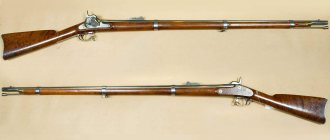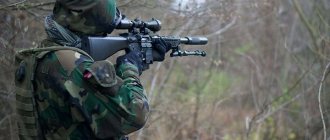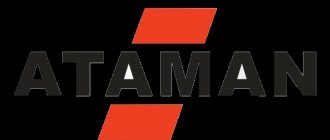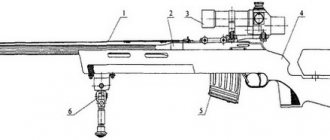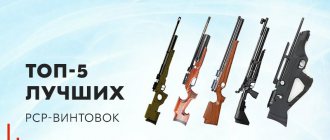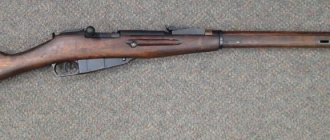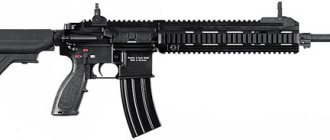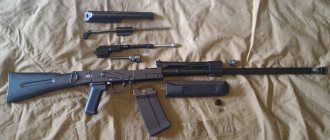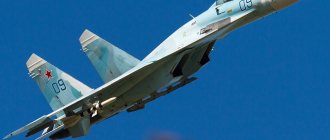“Rifle for Simo Häyhä” (continuation of the topic “Rifles by country and continent” - 1)
It has always been and will be that some people by nature do something better than others. Someone spits the farthest - well, that’s how his lips are designed. Some dive deeper than others - their lung capacity is large and their muscles are strong. Some people run, jump, write... more than others. That is, there are both purely physical reasons - “given by nature”, mental ones - the presence of intelligence, and an element of “sweating”, that is, what is given by nature is developed by exercise. And a lot depends on what “tool” you have in your hands. It is clear that with an old AVM scuba gear you will not dive as deep as with a brand new French Aquadiv, and the same can be said about weapons.
To someone whose arms initially grow out of the seat, no matter what you give him, he’s unlikely to hit the target even with the best rifle. But if a person is a “shooter from God,” then with a good rifle he will show better results than with a bad one. And here’s what’s interesting, in relation to this topic: it is known that mass sniper practice, although it had been known since the times of the American Civil War, truly became widespread during the Second World War, but in the hands of the vast majority of its snipers there was a Mosin 1891 rifle of the year!
There was a long article on the VO website about Soviet snipers, so it’s hardly worth rewriting it in this case. However, “every cuckoo praises its swamp.” Therefore, let us mention that the foreign “Sniper Center” calls the world’s first most effective sniper... the Finnish shooter Simo Häyhä. According to the center, he has hit 542 “targets”, the second one is our Ivan Sidorenko - he has 500. Turning to Wikipedia, we can find out that according to various sources, Imo shot from 542 (source - the above-mentioned “Sniper Center ") to 742 Red Army soldiers (219 killed are documented), and the difference was obtained due to the fact that he also operated with automatic weapons.
However, the Finnish shooters were not noted in any way, so all this can be attributed to propaganda, since nowhere do they lie as much as in war and hunting. On the other hand, there is no doubt that he was a marksman. But what is important in this case is what kind of rifle he shot from. And so it was our “three-ruler” that served him faithfully, but only from the “other side”, that is, he used the “Finnish three-ruler”.
Finnish “three-line” M39 (Army Museum in Stockholm)
Well, the story about it should start with the fact that Finland as a state did not exist until the October Revolution destroyed the former Russian empire and it gained independence at the behest of Lenin’s Bolshevik government. However, the Finns, even under the tsar, probably lived better than all other subjects of the Russian Empire, so it was a sin for them to complain in any case.
Photos of the weapons of the Finnish army of the 30s of the last century. Rifles from left to right: 7.62 mm M91-24 infantry rifle with M91-24 bayonet: M28 rifle with M28 Sk bayonet; M28-30 with M28-30 bayonet. (Finnish War Museum)
When the Civil War began in Russia, most Finns joined the “white” movement. Well, let's just say they supported him. The creation of its own armed forces began, and this is where the country came in very handy with the huge stocks of rifles from the Russian arsenals in Finland, which the Finns captured during the same Civil War. Thus, having acquired this entire mass of rifles, Finland very slowly and consistently began to gradually modernize them and eventually created a whole line of “three-line” rifles, which began to surpass the Russian original in a number of indicators.
M24 rifle (Army Museum in Stockholm)
First of all, we note that the Finnish model of the Mosin rifle is a slightly modernized basic model, but modernized in a thoughtful way! Which should be noted.
True, at first rifles were used without any alterations or alterations were limited to a minimum, replacing mainly barrels. Many were no different from Russian rifles, so Finnish markings appeared on the chambers - SA - “Suomi Army”. The most advanced model was the M/28 or “Pystykorva” (or “Spitz” - a slang name because of the “ears” that protected the front sight. Pystykorva, by the way, literally means the same thing - “ears up”, became the main weapon of the security forces of Finland It was also assembled from parts of an 1891 rifle, but some of the components were bought abroad.
Usually the Finns replaced Russian barrels and Russian sights. Until 1928, the old sight was used, but the Finns crossed out (scored with an oblique stroke) the Russian arshins on it and filled in their own meter scale. The rifle retained a standard 5-round magazine. The cartridge used was 7.62 × 53 mm R, that is, the bullet diameter was 7.62 mm, and the 53 mm long case had a flange (rim). This cartridge differed slightly from the original Russian 7.62 × 54 mm R cartridge, but the difference was still felt. It was fully joked by the Moscow militia, who received Finnish captured ammunition and Fr. The Finns adopted the original dagger bayonet, replacing the old needle bayonet, and the rifle itself was sighted without it. The bayonet was now attached to the stock rather than to the barrel. The trigger mechanism was also seriously modernized, which now received a release with the so-called “warning”. The neck of the stock became “pistol” like that of a German Mauser. True, such a stock neck was installed not on the Model 28, but on the M39, and then it was installed on all subsequent samples. The Finns also increased the thickness of the walls of the barrel, which had a very positive effect on improving shooting accuracy. Since Finland ordered rifle barrels abroad, the spread in calibers turned out to be quite significant. They had to be marked with Latin letters - A, B, C (the caliber of captured rifles of 1891/30 was designated in the form of the letter - D).
Russian "three-line" in the Army Museum in Stockholm.
The scale of purchases is evidenced by the following figures: in 1924, 26,000 barrels were purchased: 8,000 from SIG in Switzerland and 18,000 from three German companies.
The Finnish armed forces of the 30s of the twentieth century were divided into the regular army and the civil guard. The Guardia Civil was a national militia, and they often had their own rifle designs and a unique system of marking them.
The 1927 model was the first truly new model of the Finnish rifle. Although still containing many Russian parts, the M1927 received a new Arctic birch stock and a heavier but shorter barrel. The manufacturer was the supplier of weapons for the security corps, the SAKO workshop. The rifle went into service with the regular army, and not with the civil guard. In total, about 30,000 pieces were manufactured between 1928 and 1933. The next rifle introduced by the Finns was the Model 1928 - essentially a Civil Guard version of the Army Model 1927 rifle. The Model 1928/30 Civil Guard rifle also had a heavier barrel than the original, a thinner metal magazine, and a new scope. The result was the 1939 model. This pattern was adopted by both the army and the civil guard. True, the weight of the rifle has become greater: weight 4.3 kilograms, barrel length 68.58 cm, length 118.11 cm. The weight of the bayonet with the sheath is 449.3 grams, without the sheath 333.66 grams.
The main differences of the M28 rifle: • Four swivels, instead of the previous slots for fastening the belt, which made it possible to quickly convert its fastening into both cavalry and infantry versions. • Trigger with warning. • The neck of the butt is semi-pistol shaped. • The barrel is thicker and shorter compared to the 1891 model rifle.
The Finns began using thicker barrels already on the M24 rifle, for the modernization of which they attracted German and Swiss companies. Modernization took place in 1923-1928, and in total about 10 thousand rifles underwent such modifications.
Swivels and semi-pistol grip of the M28 rifle.
Then the state enterprise VKT twice modernized the old M91 and M24 rifles in 1929-1934. and 1939-1940 Of the 120 thousand old rifles, 55 thousand were updated. To arm snipers, some were equipped with optical sights of various types.
The M28 rifle was modernized by SAKO, for which the barrels were ordered. But then I made the barrels myself. In total, 33 thousand rifles were assembled at this enterprise.
Since 1939, the M28/30 model was produced based on the rifle. It was no different from the previous model, except that it was produced at three enterprises at once. In total, 98.6 thousand rifles of this type took part in the war. Despite the shorter barrel, the rifle weighed 4.5 kg; the initial velocity of the bullet decreased slightly and amounted to 789 m/s; and the target range of the shot is 1800 m.
A distinctive feature of the M27rv cavalry carbine (converted from a 1915 carbine), manufactured in 1934-1935. , was a curved shutter handle. Also on the sighting bar, arshins were replaced with meters. But few of them were manufactured, only about 2.2 thousand units. The weight of the carbine was 3.7 kg.
Well, now we can say a few words about Simo Häyhä. He was originally from peasants - the seventh child among eight children. He lived on a farm, hunted, fished, studied a little, and helped his older brothers become peasants. At the age of 17, having joined a local security detachment, he took up sniper shooting and performed well in sniper competitions in the Vyborg branch of this organization.
He began his military service in 1925, in a bicycle battalion, where he received the rank of non-commissioned officer. But Häyhä returned to sniping only nine years later at the Utti fortress in the town of Kouvola.
For three months of the “Winter War” of 1939-1940. he showed a record result in sniper shooting, and although the calculation was made from his words, it was confirmed by his comrades, and only those enemy soldiers who were killed by him were counted towards him. If several snipers shot at the same target at once, then the hit target was not counted towards any of them. Finnish propaganda stated that from 12/16/1939 to 03/06/1940, the norm for Häyha was 10 Red Army soldiers daily, and, of course, only the lazy did not write about him as a national hero.
However, on March 6, 1940, Häyhä was wounded by an explosive bullet in the face on the left side, as a result of which it was disfigured and his jaw was crushed. Seriously wounded, he was taken to a rear hospital and then to Helsinki, where he had to undergo several very complex operations. For example, his jaw was restored with bone taken from his thigh. Therefore, in the war of 1941-1944. he did not participate, although he asked to go to the front. There is a photograph of him after his recovery. Of course, the achievements of the medicine of that time are obvious. After this, only act in horror films!
For sniping, Häyhä used an M28-30 Spitz rifle (number 60974), and what is most surprising is that it did not have an optical sniper scope. He explained this by saying that the glass becomes covered with frost in winter, and the shine of the lenses reveals its location. And you have to hold your head higher, which is also dangerous. Many of his tactics were simple, although original. For example, he poured water on the snow under the barrel of his rifle and it did not take off from the shots and could not unmask his position. He also kept snow in his mouth so as not to give away his place with steam from his breath, and this also helped. And another gift of fate for Simo was his height of 152 cm. It was easy for someone like that to hide. It is also interesting that he did not like to shoot at long distances; it is reliably known that he did not shoot further than 450 meters.
Simo Häyhä in his winter sniping equipment and with his Finnish three-line rifle.
For his services in sniper work, Simo Häyhä received the rank of junior lieutenant from Marshal Mannerheim on August 28, 1940, was awarded the Order of the Cross of Liberty 1st and 2nd class, and also received the Silver Call Cross and a personalized sniper rifle. In the Finnish army they called him “White Death”!
After the war, Simo Häyhä bred dogs and hunted; President Urho Kekkonen himself went to him to hunt elk. When asked by journalists how he managed to become such a good sniper, he succinctly answered: “Training.” Equally revealing was his answer regarding remorse: “I did what I was ordered, and as well as I could.”
Rifles with such marks were constantly found in Finland. They were not even ground down, but simply the letters “SA” were stamped side by side.
It is interesting that the most successful Wehrmacht sniper Matthias Hetzenauer and the second after him in results Josef Allerberg also shot from a Mosin rifle...
And at the very end, here’s an interesting fact: don’t think that the Finnish army had only one “three-line” in service. Not at all, few people know that in 1941, as military assistance, she received from fascist Italy 94,500 Mannlicher-Carcano rifles and 50 million cartridges for them. But they were used exclusively in rear units and in transport. During the Winter War, the Swedes also handed over to their eastern neighbor 84,900 Swedish Mauser rifles, on which, like the Mannlicher rifles, the Finns stamped the letters “SA”. But when the war ended... the Swedes wanted to buy them back and bought those that had not fallen into disrepair!
P.S. A very informative and richly illustrated guide to rifles from all countries and peoples is this book, published in the USA in 2012 by Andrew Mobray Inc. It was written by Stuart S. Mobray and Joe V. Puleo.
To be continued…
More about the Tikka hunting rifle
The weapon in question was designed and manufactured by a Finnish armory. The original version of the rifle was called M595. It was in many ways an imperfect weapon, both in terms of design and performance. Finnish gunsmiths understood this very well, and therefore the original version of the carbine was soon modified: the design of the weapon was improved, and the technical characteristics became more acceptable. After modification, the weapon became known as Tikka T3.
From the very beginning, Finnish weapon designers were faced with the task of creating a high-quality and reliable hunting weapon, the price of which would be quite acceptable for the mass consumer. And in this sense, the Tikka T3 carbine fully corresponded to the task assigned to the designers. It has a beautiful design and also good technical characteristics. The weapon does not require any additional modification. Immediately after purchase you can go hunting with it.
Design features of the Tikka T3 hunting rifle
This gun is single-barreled and single-shot. The barrel of the weapon is rifled. Its design is simple, but at the same time elegant. There is nothing superfluous in the design of the weapon; everything here is thought out and rational. However, there is still one non-standard “zest” in the weapon: the receiver of the carbine has a faceted shape, which distinguishes it from most other analogues.
The body of the gun, as well as all its working parts, are made extremely reliably and conscientiously. High quality weapons steel was used for their production. All the mechanisms of the gun are also simple, reliable and of high quality. Especially the bolt, which is the main element of the weapon. Gun users have no comments or complaints about it at all. The bolt, like all other working mechanisms of the gun, is made according to the classical standard, is double-lug with a spring-loaded extractor, and works clearly and flawlessly, and therefore the gun can be reloaded easily and simply.
In Russia, guns are sold with wooden and plastic butts. Moreover, due to tradition, guns with a wooden butt and forend are in greater demand here than with plastic ones. As for the assembly, the weapon is assembled, as they say, to the highest class. Everything is accurate, everything fits, nothing rattles or flops around. For this reason, the carbine has a high margin of safety and reliability. Upon release, the entire surface of the rifle is treated with a special material that protects the weapon from rust and abrasion for a long time.
The sighting mechanisms of the gun are also screen-printed. They can be easily removed and an optical sight installed in their place. The fuse box is located on the right.
Final characteristics of the Finnish hunting rifle Tikka T3
This is a weapon that is easy to use and easy to design, and is also extremely reliable. During the entire operation of the rifle, there were no serious complaints from its users regarding the quality of the weapon.
An additional advantage of the gun is a large selection of modifications. Anyone who wants to purchase a weapon of this particular brand for himself will certainly find a model to his liking. In addition (and this is another undoubted advantage of this weapon), its price is quite acceptable for most Russians. The initial cost of the gun is about $1,000.

